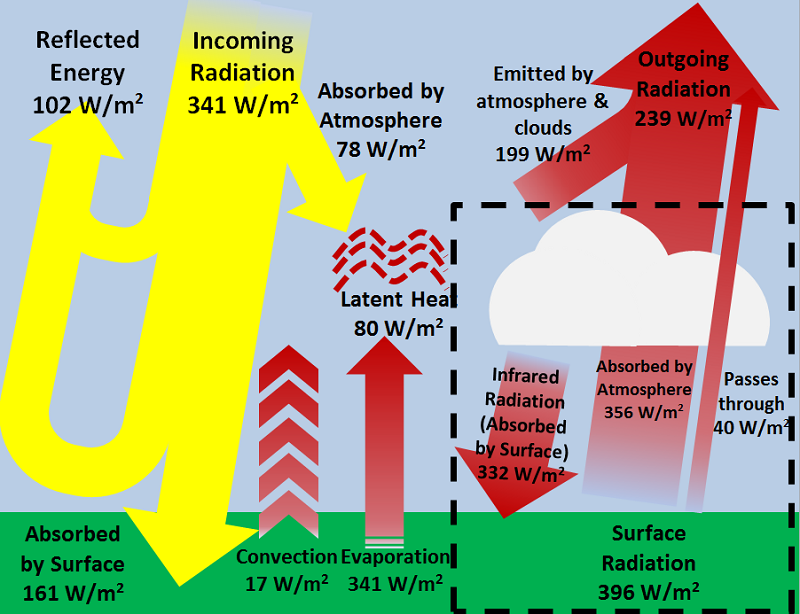The greenhouse effect and Earth's energy budget
The greenhouse effect plays a significant role in Earth's energy budget. With the natural greenhouse effect, the energy budget is balanced as thermal radiation is re-radiated towards the ground, trapping thermal energy and warming the Earth. However, with the greenhouse effect being enhanced by humans, the energy budget of the Earth is shifted to an imbalance. It is important to understand that a certain amount of energy being retained due to the greenhouse effect is necessary, but too much results in conditions that account for increased global temperatures and climate change.[1]
Importance in Energy Budget
When referring to the Earth's climate, greenhouse effect is the natural heating of a planet's surface from absorption by atmospheric greenhouse gases such as methane, carbon dioxide, and water vapour.[1] Without the greenhouse effect, the Earth would not be in an energy balance. Thus to account for this offset, the temperature of the Earth would decrease to a new state of equillibrium. This new temperature—the temperature without the greenhouse effect—would be far too cold for life as we know it to exist.

To elaborate on what is happening in Figure 1, we can see that the atmosphere absorbs a certain amount of radiation that came from the surface of the Earth. Some of this energy passes through the atmosphere but some is absorbed and re-radiated. The greenhouse effect collects and redistributes the energy in this manner by allowing shorter wavelengths of light to pass through the atmosphere while absorbing longer wavelengths of infrared radiation, later re-radiating that energy back towards the surface. This results in the trapping of longer wavelengths and a higher temperature on the surface of the Earth.[3]
Contribution to Warming
Although the greenhouse effect is necessary in maintaining a temperature on Earth that allows life as we know it to exist, if more greenhouse gases are added into the atmosphere the delicate balance established by the energy budget is disrupted. When more carbon dioxide, for example, is added into the atmosphere, the amount of energy absorbed and then re-emitted by the atmosphere is increased. Since any offset in the energy balance of the Earth must result in a temperature change to account for the difference, the temperature on the Earth increases to create balance once again. Since the addition of carbon dioxide to the atmosphere increases the effect of the greenhouse effect and increases the temperature, the addition is known as climate forcing as it destabilizes the Earth's temperature.[4]
The reason that carbon dioxide poses such a risk in terms of upsetting the balance of the Earth's energy budget is because it absorbs a significant amount of thermal energy.[4] By adding more carbon dioxide to the atmosphere, the atmosphere becomes more "closed" to energy passing through it, absorbing more. Therefore, thermal energy that once would have been allowed to escape into space is instead absorbed by carbon dioxide and used to heat the Earth.
The changes in the climate that have occurred so far will continue to happen as the energy imbalance continues to grow with the release of greenhouse gases into the atmosphere. Surface temperatures have risen between 0.6 and 0.9 degrees Celsius, and projections estimate that temperatures will likely rise at least 0.6 degrees in response to the continuing energy imbalance.[4] Thus it is important to reduce the emission of greenhouse gases as it will help to reduce this imbalance, ensuring that the only effect that the greenhouse effect has on the energy budget is the one it is intended to have.
For Further Reading
- Renewable and sustainable energy
- Fossil fuel
- Law of conservation of energy
- Energy efficient building design
- Or explore a random page
References
- ↑ 1.0 1.1 R. Wolfson, (May 8, 2015). Energy, Environment and Climate, 2nd ed. New York, U.S.A.: Norton, 2012.
- ↑ Created internally by a member of the Energy Education team. Adapted from: R. Wolfson, Figure 12.5 in Energy, Environment and Climate, 2nd ed. New York, U.S.A.: Norton, 2012, pp. 331
- ↑ HyperPhysics. (May 1, 2015). The Greenhouse Effect [Online]. Available: http://hyperphysics.phy-astr.gsu.edu/hbase/thermo/grnhse.html
- ↑ 4.0 4.1 4.2 NASA Earth Observatory. (May 8, 2015). Climate and Earth's Energy Budget [Online]. Available: http://earthobservatory.nasa.gov/Features/EnergyBalance/page7.php

